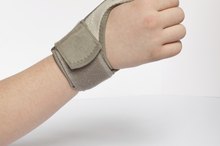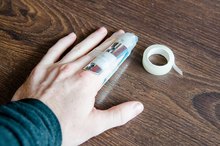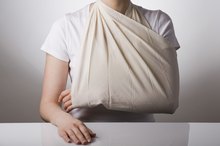Signs of a Torn Ligament in the Finger
Ligaments are strong bands of connective tissue that connect bone to bone. These structures keep your joints stable as you move. Finger ligament injuries can cause long-term complications if they are not promptly diagnosed 3. Even with proper treatment, permanent finger deformities may develop. See your doctor if you notice signs of a torn finger ligament.
If you are experiencing serious medical symptoms, seek emergency treatment immediately.
Joint Instability
Ligaments support each side of your individual finger joints. These structures keep your finger bones in proper position. Ligaments on either side of the middle joint of your fingers are most commonly injured 2. Such injuries are sometimes referred to as “jammed fingers.” When a physician applies pressure to a joint that has suffered a ligament tear, she may find that the finger moves excessively to one side, indicating that the ligament is stretched or torn. Joint instability may also keep you from fully bending or straightening your finger.
- Ligaments support each side of your individual finger joints.
- When a physician applies pressure to a joint that has suffered a ligament tear, she may find that the finger moves excessively to one side, indicating that the ligament is stretched or torn.
Excessive Mobility
What Causes Finger Joint Pain?
Learn More
The volar plate is a sturdy band of connective tissue crossing the front of the joints in the middle of your fingers. These structures prevent your fingers from bending too far backward. Volar plates can be partially or completely torn -- particularly if your finger is forced backward. A volar plate injury may also remove chunk of bone, called an avulsion fracture. Hyperextension, or excessive backward bending, can be a sign of a torn volar plate. This injury may also cause the finger joint to dislocate, making the finger appear crooked.
- The volar plate is a sturdy band of connective tissue crossing the front of the joints in the middle of your fingers.
- Hyperextension, or excessive backward bending, can be a sign of a torn volar plate.
Pain and Weakness
Finger ligament injuries typically cause sharp pain at the affected joint 1. The area may also bruise, and your entire finger may swell. These signs occur soon after injury. Within a few weeks, bruising and swelling typically subside. However pain often continues for several months as the ligament heals. Finger weakness may develop with decreased joint stability, making fine motor tasks difficult.
- Finger ligament injuries typically cause sharp pain at the affected joint 1.
- Finger weakness may develop with decreased joint stability, making fine motor tasks difficult.
Related Articles
References
- Strategies in Trauma and Limb Reconstruction: Collateral Ligament Injuries of the Metacarpophalangeal Joint of the Thumb
- American Academy of Family Physicians: Acute Finger Injuries -- Part I. Tendons and Ligaments
- Elfar J, Mann T. Fracture-dislocations of the proximal interphalangeal joint. J Am Acad Orthop Surg. 2013;21(2):88-98. doi:10.5435/JAAOS-21-02-88
- OrthoInfo from the American Academy of Orthopaedic Surgeons. Hand fractures. Updated March 2018.
- Hung CY, Varacallo M, Chang KV. Gamekeepers thumb (skiers, ulnar collateral ligament tear). StatPearls. Updated August 10, 2020.
- OrthoInfo from the American Academy of Orthopaedic Surgeons. Finger fractures. Updated December 2013.
- Borchers JR, Best TM. Common finger fractures and dislocations. Am Fam Physician. 2012;85(8):805-810.
- Harvard Health Publishing. Finger dislocation. Updated April 2019.
Writer Bio
For 15 years, Charis Grey's award-winning work has appeared in film, television, newspapers, magazines and on the Internet. She has worked as a story editor on the CBS drama "Flashpoint" and her work appears bimonthly in "The Driver Magazine." She has a Bachelor of Science in biology and a doctorate in chiropractic medicine from Palmer College.









